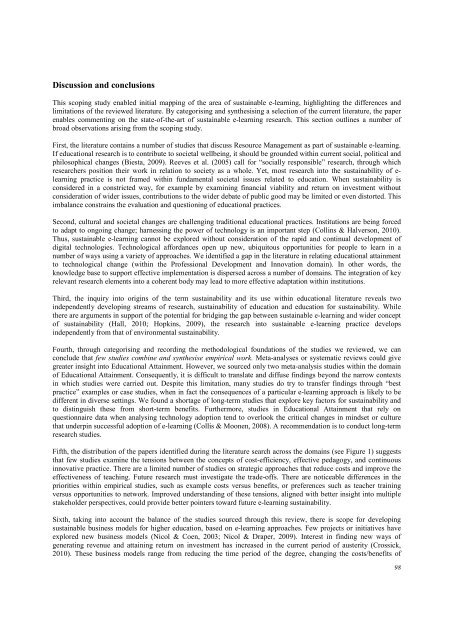Download Complete Issue in PDF - Educational Technology & Society
Download Complete Issue in PDF - Educational Technology & Society
Download Complete Issue in PDF - Educational Technology & Society
You also want an ePaper? Increase the reach of your titles
YUMPU automatically turns print PDFs into web optimized ePapers that Google loves.
Discussion and conclusions<br />
This scop<strong>in</strong>g study enabled <strong>in</strong>itial mapp<strong>in</strong>g of the area of susta<strong>in</strong>able e-learn<strong>in</strong>g, highlight<strong>in</strong>g the differences and<br />
limitations of the reviewed literature. By categoris<strong>in</strong>g and synthesis<strong>in</strong>g a selection of the current literature, the paper<br />
enables comment<strong>in</strong>g on the state-of-the-art of susta<strong>in</strong>able e-learn<strong>in</strong>g research. This section outl<strong>in</strong>es a number of<br />
broad observations aris<strong>in</strong>g from the scop<strong>in</strong>g study.<br />
First, the literature conta<strong>in</strong>s a number of studies that discuss Resource Management as part of susta<strong>in</strong>able e-learn<strong>in</strong>g.<br />
If educational research is to contribute to societal wellbe<strong>in</strong>g, it should be grounded with<strong>in</strong> current social, political and<br />
philosophical changes (Biesta, 2009). Reeves et al. (2005) call for “socially responsible” research, through which<br />
researchers position their work <strong>in</strong> relation to society as a whole. Yet, most research <strong>in</strong>to the susta<strong>in</strong>ability of elearn<strong>in</strong>g<br />
practice is not framed with<strong>in</strong> fundamental societal issues related to education. When susta<strong>in</strong>ability is<br />
considered <strong>in</strong> a constricted way, for example by exam<strong>in</strong><strong>in</strong>g f<strong>in</strong>ancial viability and return on <strong>in</strong>vestment without<br />
consideration of wider issues, contributions to the wider debate of public good may be limited or even distorted. This<br />
imbalance constra<strong>in</strong>s the evaluation and question<strong>in</strong>g of educational practices.<br />
Second, cultural and societal changes are challeng<strong>in</strong>g traditional educational practices. Institutions are be<strong>in</strong>g forced<br />
to adapt to ongo<strong>in</strong>g change; harness<strong>in</strong>g the power of technology is an important step (Coll<strong>in</strong>s & Halverson, 2010).<br />
Thus, susta<strong>in</strong>able e-learn<strong>in</strong>g cannot be explored without consideration of the rapid and cont<strong>in</strong>ual development of<br />
digital technologies. Technological affordances open up new, ubiquitous opportunities for people to learn <strong>in</strong> a<br />
number of ways us<strong>in</strong>g a variety of approaches. We identified a gap <strong>in</strong> the literature <strong>in</strong> relat<strong>in</strong>g educational atta<strong>in</strong>ment<br />
to technological change (with<strong>in</strong> the Professional Development and Innovation doma<strong>in</strong>). In other words, the<br />
knowledge base to support effective implementation is dispersed across a number of doma<strong>in</strong>s. The <strong>in</strong>tegration of key<br />
relevant research elements <strong>in</strong>to a coherent body may lead to more effective adaptation with<strong>in</strong> <strong>in</strong>stitutions.<br />
Third, the <strong>in</strong>quiry <strong>in</strong>to orig<strong>in</strong>s of the term susta<strong>in</strong>ability and its use with<strong>in</strong> educational literature reveals two<br />
<strong>in</strong>dependently develop<strong>in</strong>g streams of research, susta<strong>in</strong>ability of education and education for susta<strong>in</strong>ability. While<br />
there are arguments <strong>in</strong> support of the potential for bridg<strong>in</strong>g the gap between susta<strong>in</strong>able e-learn<strong>in</strong>g and wider concept<br />
of susta<strong>in</strong>ability (Hall, 2010; Hopk<strong>in</strong>s, 2009), the research <strong>in</strong>to susta<strong>in</strong>able e-learn<strong>in</strong>g practice develops<br />
<strong>in</strong>dependently from that of environmental susta<strong>in</strong>ability.<br />
Fourth, through categoris<strong>in</strong>g and record<strong>in</strong>g the methodological foundations of the studies we reviewed, we can<br />
conclude that few studies comb<strong>in</strong>e and synthesise empirical work. Meta-analyses or systematic reviews could give<br />
greater <strong>in</strong>sight <strong>in</strong>to <strong>Educational</strong> Atta<strong>in</strong>ment. However, we sourced only two meta-analysis studies with<strong>in</strong> the doma<strong>in</strong><br />
of <strong>Educational</strong> Atta<strong>in</strong>ment. Consequently, it is difficult to translate and diffuse f<strong>in</strong>d<strong>in</strong>gs beyond the narrow contexts<br />
<strong>in</strong> which studies were carried out. Despite this limitation, many studies do try to transfer f<strong>in</strong>d<strong>in</strong>gs through “best<br />
practice” examples or case studies, when <strong>in</strong> fact the consequences of a particular e-learn<strong>in</strong>g approach is likely to be<br />
different <strong>in</strong> diverse sett<strong>in</strong>gs. We found a shortage of long-term studies that explore key factors for susta<strong>in</strong>ability and<br />
to dist<strong>in</strong>guish these from short-term benefits. Furthermore, studies <strong>in</strong> <strong>Educational</strong> Atta<strong>in</strong>ment that rely on<br />
questionnaire data when analys<strong>in</strong>g technology adoption tend to overlook the critical changes <strong>in</strong> m<strong>in</strong>dset or culture<br />
that underp<strong>in</strong> successful adoption of e-learn<strong>in</strong>g (Collis & Moonen, 2008). A recommendation is to conduct long-term<br />
research studies.<br />
Fifth, the distribution of the papers identified dur<strong>in</strong>g the literature search across the doma<strong>in</strong>s (see Figure 1) suggests<br />
that few studies exam<strong>in</strong>e the tensions between the concepts of cost-efficiency, effective pedagogy, and cont<strong>in</strong>uous<br />
<strong>in</strong>novative practice. There are a limited number of studies on strategic approaches that reduce costs and improve the<br />
effectiveness of teach<strong>in</strong>g. Future research must <strong>in</strong>vestigate the trade-offs. There are noticeable differences <strong>in</strong> the<br />
priorities with<strong>in</strong> empirical studies, such as example costs versus benefits, or preferences such as teacher tra<strong>in</strong><strong>in</strong>g<br />
versus opportunities to network. Improved understand<strong>in</strong>g of these tensions, aligned with better <strong>in</strong>sight <strong>in</strong>to multiple<br />
stakeholder perspectives, could provide better po<strong>in</strong>ters toward future e-learn<strong>in</strong>g susta<strong>in</strong>ability.<br />
Sixth, tak<strong>in</strong>g <strong>in</strong>to account the balance of the studies sourced through this review, there is scope for develop<strong>in</strong>g<br />
susta<strong>in</strong>able bus<strong>in</strong>ess models for higher education, based on e-learn<strong>in</strong>g approaches. Few projects or <strong>in</strong>itiatives have<br />
explored new bus<strong>in</strong>ess models (Nicol & Coen, 2003; Nicol & Draper, 2009). Interest <strong>in</strong> f<strong>in</strong>d<strong>in</strong>g new ways of<br />
generat<strong>in</strong>g revenue and atta<strong>in</strong><strong>in</strong>g return on <strong>in</strong>vestment has <strong>in</strong>creased <strong>in</strong> the current period of austerity (Crossick,<br />
2010). These bus<strong>in</strong>ess models range from reduc<strong>in</strong>g the time period of the degree, chang<strong>in</strong>g the costs/benefits of<br />
98

















